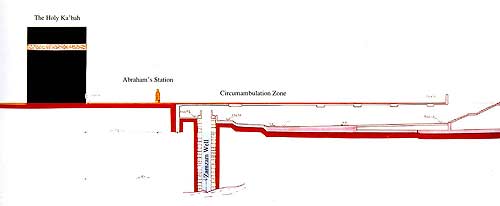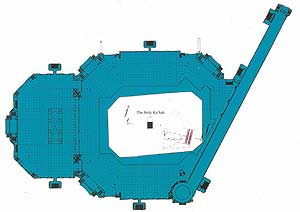>
The Components of the Building Materials Used
for the Construction of the Holy Ka'bah

Side diagrammatic presentation of the Holy Ka'bah site The construction of the Holy Ka'bah in its present form is the building by Sultan Murad IV, one of the Ottoman Sultans in 1040 H. This same construction has been renovated by the Custodian of the Two Holy Mosques (may Allah protect him). It in a strong, solid building whose components are the large bluish-black stones taken from Makkah Al-Mukarramah mountains, the most important of which is AI-Ka bah mountain at the Shubeikah site.
The stones are not equal in size; some are large, others small. The largest stone was 190 centimetres long, half a metre wide and 28 centimetres thick. The smallest stone was half a metre long, and approximately 40 centimetres wide. The ends of these stones were mortared into the wall, the exposed rocks looking like rows of molars. On the base of the Holy Ka'bah from without, there is AI-Shadhrwan whose marble stones are different from those of the wall of the Holy Ka'bah.
The Shadhrwan of the Holy Ka'bah
The Shadhrwan is a part of the wall of the Sacred House. It protrudes out of the base of the Holy Ka'bah, and is called a wrapping because it wraps around the Sacred House from three sides. The Shadhrwan renovated by the Custodian of the Two Holy Mosques, was constructed by Sultan Murad IV when fie built the Holy Ka bah in 1040 H.
It was not remade but renovated by the Custodian of the Two Holy Mosques. It consists of the sloping stones fixed to the bottom of the Holy Ka'bah, and surrounding it on three sides. The part opposite to Hijir Ismail (peace be upon him) is not part of the Shadhrwan. It is a rocky threshold II centimetres high and 40 centimetres wide.
Some circumambulators stand on the threshold of the door of the Holy Kabah, clinging to it in supplication.
|
 |
 The general site of the Ka'bah. |
The Shadhrwan was not set up in the Hijir because it represents the northern end of the Sacred House which extends six cubits and one hand span into Hijir Ismail (peace be upon him). The Shadhrwan was not set at the bottom of the door of the Holy Ka'bah so people could hang on to the threshold of the door of the Holy Ka'bah and AI-Multazam for supplication. Instead of the Shadhrwan, there is a threshold 3 metres and 45 centimetres long, slightly raised from the circumambulation area. The Shadhrwan is, in reality, a part of the Holy Ka'bah. It was said that it was first set up by Abdullah Ibn AI-Zubair (may Allah be pleased with them) on the foundations of Abraham (peace be upon him) to protect the wall of the Holy Ka'bah from water leaking into it. He tied the ropes of the curtains of the Holy Ka bah to rings fixed on it for this purpose. They were fixed to keep the circumarnbulators from being hurt and to avoid damage to the curtains of the Holy Ka'bah. The Shadhrwan was renovated in 1098 H. by Abroad Pasha. All the stones of the Shadhrwan were made of the white, strong, solid marble in varying sizes. It consisted of 71 stones, eight of which were on the side of the door of the Holy Ka'bah to the north. These stones were of the most precious marble in the world. There were forty-one rings fixed to the Shadhrwan to fasten the ropes of the curtains of the Holy Ka'bah. |
